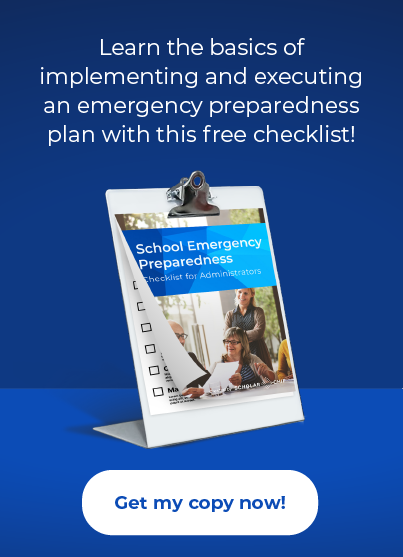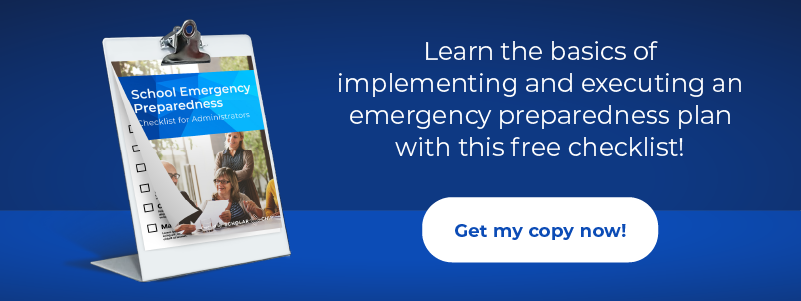Due to COVID-19, schools and districts have difficult decisions in the next few months. Will they continue remote learning? Stagger classes? Bring everyone back and increase cleaning and monitoring protocols?
As schools brace for the new and continued challenges caused by the pandemic, they are reviewing their responses from the spring with a fresh perspective. Some are realizing that they were ill-prepared for the magnitude of the situation.
Whether they handled the crisis well or there was room for improvement in their response, administrators are now taking a hard look at their protocols and plans going forward. Doing so is essential to keeping students safe and limiting enrollment attrition by concerned parents.
As you work through your evaluation of the coronavirus response in your school, you’ll likely realize that this is the perfect opportunity to update your school emergency plans.
Updating these plans cannot be haphazard. There are certain things to keep in mind that will make the process go smoothly and ensure that you get the most out of the time spent.
Best Practices for Updating Your School Emergency Plans
Much should go into updating your school’s emergency plan. Some tasks are similar to when you initially created the plan, while others are unique to the update process. Whether this is your first time updating your plan or your tenth, you should be sure to include the following five focus areas.
Define Your Timeline with Your Core Team
Updating your plan requires engaging your core team, from administrators and staff to board members and first responders. Keeping a diverse group like this on task can be a challenge. Each individual has other responsibilities in addition to making plan updates. Getting this done in a timely manner will require a timeline that is both realistic and keeps the ball moving.
Work with your team to understand the scope of the changes that will need to be made and the effort involved from each of them to do so. Then, define your milestones and add dates. You should stress the importance of meeting deadlines to keep the project on task. Even then, you may need to make a few adjustments along the way and use your update schedule to set reasonable expectations.
Update and Review the Risks
Revising your school’s emergency plans isn’t just about adding to or refining the ways in which you respond. It’s also an opportunity to add new risks and threats that may have surfaced since your last update.
Tap into your network of peers throughout your district, state, and country to get an understanding of risks that you weren’t previously aware of but that now need to be addressed.
Another source of information for new risks is your own school’s internal changes. Things like recently adopted cleaning protocols for COVID-19 prevention may have added chemicals or other threats into the school environment, and responses to things like spills or other accidents should be included in your plans. Another internal change that might warrant crisis response mapping is acquiring new science lab equipment, materials, or chemicals.
Institutionalize Training
With any skill, practice is crucial to mastery. That is also true for emergency preparedness. Your plan updates should consider how to institutionalize practice to keep teams trained and ready.
Tabletop simulations, workshops, and drills keep teams current on their skills and knowledge of what must be done during an event. A practice run makes the actions required to keep students and other staff safe second nature.
Drills and simulations serve other purposes as well. By exercising your plans when there is no active emergency, it’s possible to spot flaws or holes in your processes. Drills also allow you to test your equipment so you know it’s in working order.
Evaluate New Solutions
Advancements in technology and equipment are being made all the time. Part of updating your school emergency plans should include researching and evaluating new solutions. These new products can help streamline and strengthen your threat readiness posture.
For instance, validating attendance during the chaos of a crisis can be a challenge. It’s something that a smart-card-based technology solution can simplify. If you’ve been considering adding a smart-card system into your attendance process, evaluating its effectiveness during an emergency might help you make that decision.
Refine with Preventative and Proactive Plans
The benefit of updating an existing school emergency plan is the ability to refine responses even further. Part of that refining process should include preventative and proactive solutions for identified threats and risks.
For instance, think about how you manage the risk of dangerous chemicals. You don’t just create a plan for safely cleaning up spills and then leave containers of chemicals around. You place those chemicals in a designated area, surrounded by the equipment needed to respond to an unfortunate event—an eyewash station near the storage, a fire blanket nearby, etc. A storage plan is a proactive measure that’s part of risk management.
The same sort of planning should be considered when reviewing other threats and risks. For example, you likely have emergency plans for dealing with a visitor who becomes a threat.
Refining your plan further could focus on preventing or limiting access to the campus instead of only having reactionary plans. That might include perimeter locks that require a smart card to activate or a visitor management system that allows you to record and screen outsiders. A visitor management system can perform checks against sex offender databases, as well as facilitate pickup authorization validation, further protecting students.
Upgrading your emergency plan is as important as initially creating it. A great deal goes into the updates, but by following a few simple rules, you can be sure that you’re reviewing and revising it in the ways that will benefit school safety the most. Establish a timeline for the updates, remember to look at new threats and new ways to manage existing protocols, schedule drills and simulations, and add in preventative measures to your reactive plans. Keeping an eye on these five elements will help create school emergency plans that avoid threats as much as they prepare to deal with them.
ScholarChip offers holistic school safety services aligned with CDC guidelines to help schools reopen amidst growing health concerns. Through our advanced technology, built and designed for the K-12 environment, schools can identify risks and mitigate the spread of infection. Our solutions include fever screening, visitor surveys, symptom and vaccine tracking, in-school contact tracing, alerts and notifications. Learn more about our advanced COVID-19 solutions or request a reopening strategy session today!


